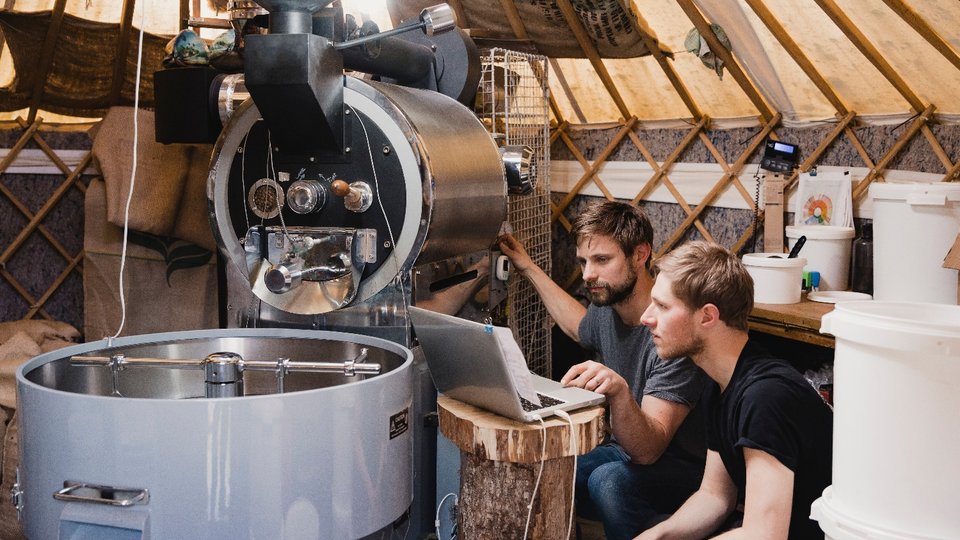Coffee Service
How to select a commercial coffee roaster
Commercial coffee businesses choose to use in-house roasters to offer fresher product, better control of the entire process, improved transparency of products and opportunities to diversify the business. Considerations include price, volume, ease of use and more.

June 12, 2023
Whether you are starting a coffee roasting business or you would like to start making different types of coffee roasts in-house, the high price tag of a commercial coffee roaster means you want to get your purchase right from the start. This article will go over the different types of coffee roasters out there and which heating methods they utilize to help you choose the best roaster for your business.
Purchasing considerations
Before purchasing a commercial coffee roaster, the main factors you will need to determine are how much coffee you will produce in a day, your budget, and how much control you would like to have over the roasting process.
- Size. To determine which size roaster you will need, you will want to consider the drum capacity of the unit. A operation may only need a roaster with a 3-kilogram drum capacity versus a roastery servicing multiple locations that may require a coffee roaster with a large drum capacity of 30 kilograms.
- Price. While your budget should be a consideration when purchasing any coffee equipment, you should also keep in mind how often you will be using your roaster, who will be operating the roaster, and the features you need when determining the cost. While high-quality roasters are generally more expensive, they have more advanced technology and are easier to use.
- Features. If you want complete control over the roasting process, look for roasters with manual flame, drum speed and airflow control features. Compatibility with roast profiling software is another helpful feature to ensure that every batch will produce the same quality, regardless of who operates the machine.
- Ease of use. If you operate a higher-volume establishment where multiple people will be running the roaster in a day, you will need a roaster with easy-to-use controls.
Drum coffee roasters and fluid bed coffee roasters are the two main types of commercial coffee roasters used by professionals. Drum coffee roasters are more widely used and utilize conduction and convection heating to roast beans. Fluid bed coffee roasters only utilize convection heating and are gaining popularity for their smooth, even roasting.
Drum coffee roaster
The most popular and economical type of roaster is a commercial drum coffee roaster. This roaster machine features a solid drum that rotates over a gas flame to heat the coffee beans.
The beans receive both conductive heat transfer by making direct contact with the surface of the drum and convection heat transfer from the ambient air inside the drum.
Drum roasters have paddles inside the drum to mix the beans as the drum rotates and ensure they receive the right blend of conductive and convective heat.
Drum coffee roasters come in two types: single-wall drums and double-wall drums. A single-wall drum roaster is the classic type of drum roaster, whereas the outer wall of a double-wall drum roaster uses air to heat the inner wall and provide a more stable roasting experience.
Generally, a drum roaster is easy to control and manipulate. However, if too much heat transfers to the beans via direct contact with the drum or the speed of the rotating drum is set too high, the coffee beans can end up scorched and their flavor distorted.
Pros:
- Gives the beans a deep, full-bodied flavor.
- Applies both conductive and convective heat sources to roast beans.
- Flexibility in control.
- Available in single-wall and double-wall styles for preference.
- Comes in a variety of sizes.
- Ideal for high-volume roasting.
Cons:
- Some beans may get burnt in the roasting process when they have direct contact with the drum.
- Can be harder to duplicate roast profiles.
- Longer roasting time than fluid bed coffee roasters.
Fluid bed coffee roasters
A fluid bed coffee roaster relies solely on convection heat transfer to roast coffee beans. It consists of a tall cylinder where hot air rises through a chamber into the roaster and causes the coffee beans to float in a fluidized bed of hot air to roast them. A fluid bed coffee roaster is typically electric, which can be great for companies trying to reduce their carbon footprint.
Compared to drum roasters, fluid bed roasters are known for roasting coffee beans more evenly and in a quicker amount of time as the air has complete and constant contact with them. These roasters eliminate the risk of scorching associated with conductive heat since the beans do not come in direct contact with the roaster. They are usually compact machines, making them ideal for small-batch roasting.
Pros:
- Roasts coffee faster and with less energy than drum roasters.
- Provides more even heat distribution and a more consistent roast.
- Less likely to scorch beans.
- Compact size is ideal for small roasteries.
Cons:
- Not ideal for high-volume batches.
- Typically more expensive.
- Harder to produce a full-bodied coffee flavor than with drum roasters.
Conduction versus convection
The coffee roasting process involves heating the coffee beans to induce the "Maillard reaction" and bring out a coffee bean's unique flavor profile. Roasting transforms the coffee bean from its green, grassy and bitter raw state into the brown, fragrant and complex bean people love.
Along with the type of roaster used, the heating method used will also impact the development of the coffee's characteristics. Fluid bed roasters solely rely on convective heat to roast the coffee beans, and drum roasters use a mix of conductive and convective heat.
Conductive heat.Conductive heat occurs when heat transfers between two objects in contact with each other. When roasting coffee, this refers to when the beans come into contact with the hot metal surface of a drum roaster.
Conductive heat transfer is a more traditional style of roasting that roasts the beans from the outside in, similar to cooking meat in a frying pan.
Convective heat. Convective heat is the transfer of heat through a liquid or gas. When roasting coffee, this refers to when heat is applied indirectly to the beans via hot air.
Coffee roasters use a fan or pump to pull air into the roaster and heat the beans. Convective heat transfer is a more modern and upcoming style of roasting that roasts the inside out, similar to baking.
Electric versus gas roaster
Electricity and gas are two different heating methods that can power coffee roasters. The main difference between electric coffee roasters and gas coffee roasters is their responsiveness to heat changes.
Gas roasters can change temperatures quickly, whereas electric roasters respond more slowly. Both can produce high-quality coffee beans, so the type of fuel you choose will mostly rely on preference and location.
Electric pros:
- More energy efficient.
- Does not require a gas line and is more flexible in placement.
- Little to no emissions.
- Programming provides more consistency.
- No permits required.
Electric cons:
- The heating element takes longer to heat up and cool down.
- Typically has a more expensive upfront cost.
Gas pros:
- Provides precise control.
- Changes temperatures faster.
- More size options are available.
- More powerful.
Gas cons:
- Not as energy efficient.
- Requires a gas line and permits.
Benefits of roasting in-house
It is no wonder that in-house roasting is trending in coffee service operations as operators look for ways to improve their products and customer loyalty. It will allow you to serve the freshest coffee possible for a superior taste but also increase engagement with your local community.
Benefits include:
- Fresher product. The freshness of your coffee is a huge selling point to your customers. A unique, superior-roasted bean might mean converting a one-time or occasional customer to a devoted, loyal customer for years to come.
- Better control. By bringing your coffee roasting in-house, you can control the entire coffee-making process, from developing the coffee's roast profile to controlling its grind size and brewing method. By controlling the coffee's quality from beans to brewing, you can ensure the coffee's taste profile is to your liking and provide a unique product to your patrons.
- Transparency. By aligning with customers' values, such as shopping local and preserving a coffee region's characteristics, you can attract new customers by roasting in-house. Consider purchasing fair trade or single-origin coffee to increase your establishment's transparency and ensure your beans come from a reputable, ethical source.
- Wholesale opportunities. Creating your own signature roasts and blends allow you to market bags of freshly-roasted beans to customers, sell them online and create a coffee subscription service. You can also sell your different coffee roasts to other local businesses to increase brand recognition in your area.
This article was provided by WebstaurantStore.com.







